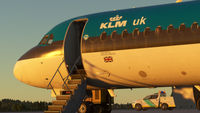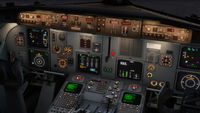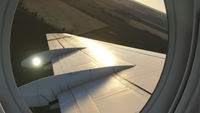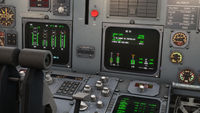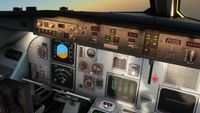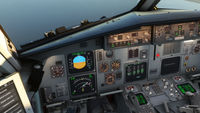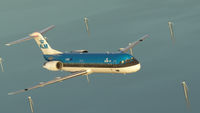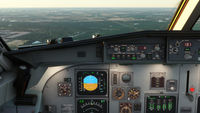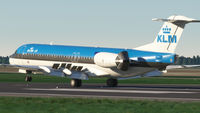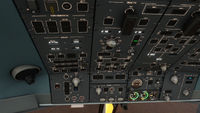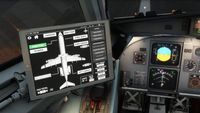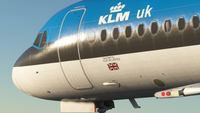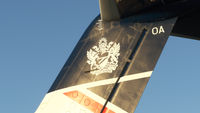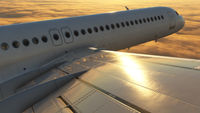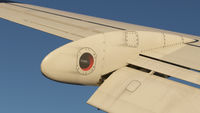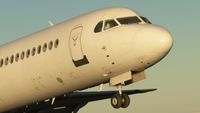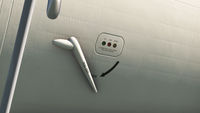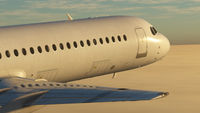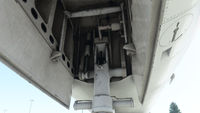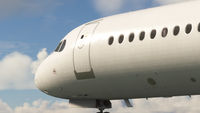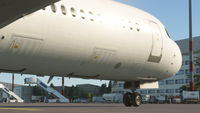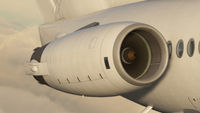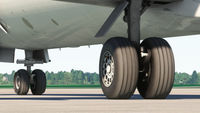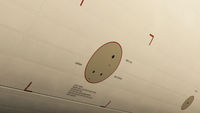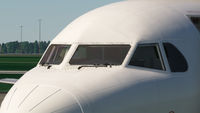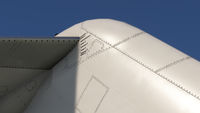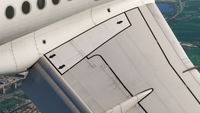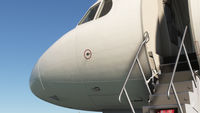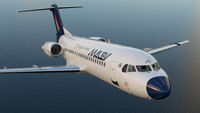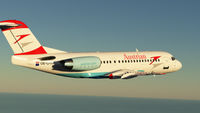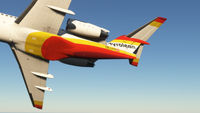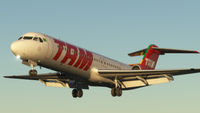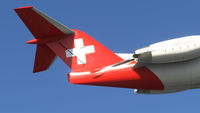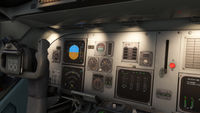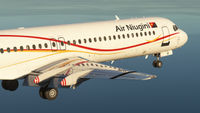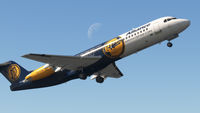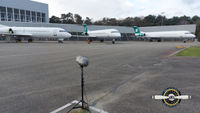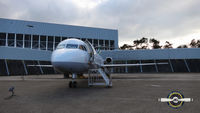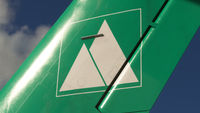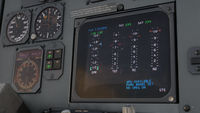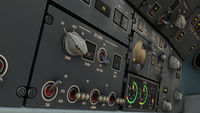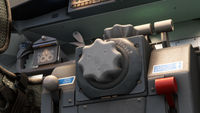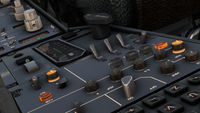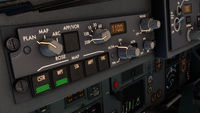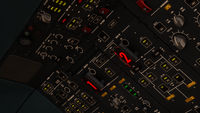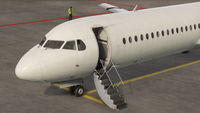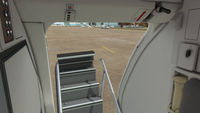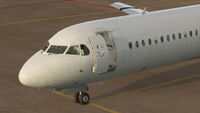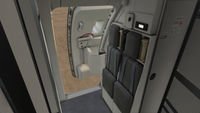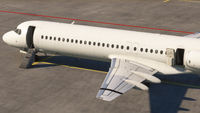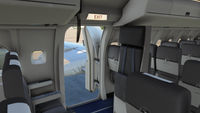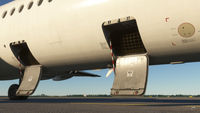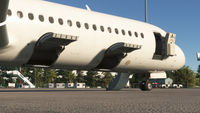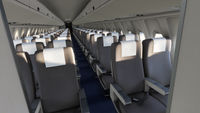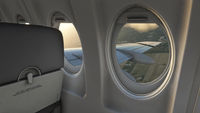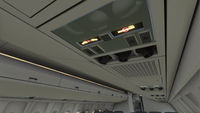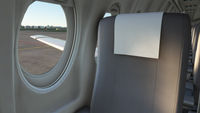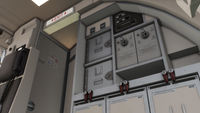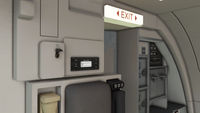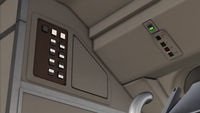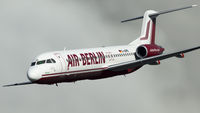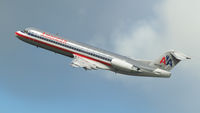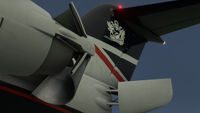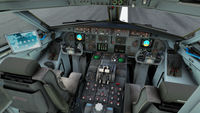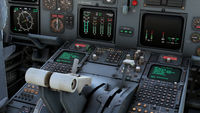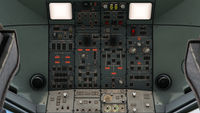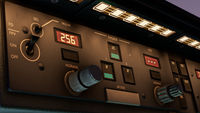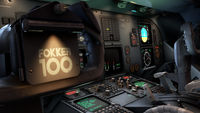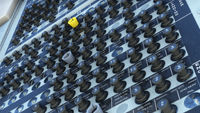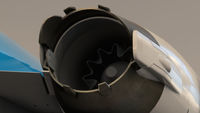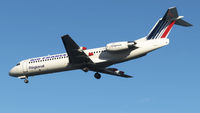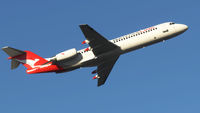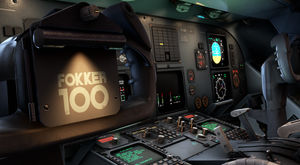05 March 2025
Welcome to the next Development Update for our F70/100 Professional for MSFS.
Since our last update, the team has been busy implementing the rest of the basic aircraft systems such as the lift dumpers, airbrake, and the external and cockpit lighting, including new artwork for the F100’s LCD display backlights. These might be only small details but they certainly make a big difference to the overall feel.
Most recently, much of our time has been spent on the more complex systems of the F100, related to the electronic flight information system (EFIS). A major milestone is the inclusion of the Flight Warning System (FWS). This monitors aircraft systems for both normal and abnormal situations and displays various levels of memos, alerts, status messages, and procedures on the centre screens known as MFDUs.
We’ve also started in-depth testing of the F100’s equally complex and very capable autopilot (AFCAS) and FMS. Testing this is a time-consuming process because many different scenarios need to be tested to ensure everything is working across all areas of the flight envelope. There’s nothing more unsatisfying than when the aircraft nose-dives into the ground at the end of a 2-hour flight. Ask us how we know!
With all of these systems coming together, we have now entered a period of intensive testing and bug fixing, with our expert team of F100 pilots and engineers now involved. The nature of a modern aircraft such as the F70/F100 means that testing will continue for a while yet, as a seemingly endless number of combinations of situations and scenarios need to be covered.
As the systems on the F100 mature, we will soon be turning our attention to the F70. This will require some changes to the cockpit panels and tweaks to the flight models to account for the shorter aircraft’s lower weights, different geometry, and slightly different engine performance.
Finally, coming up in the next month will be the integration of the sounds from Sim Acoustics. The whole team cannot wait to get our hands on this, and we’ll be keen to share videos with you once everything is in place. You can read Mike’s experience recording those sounds from the real aircraft in one of our previous in-development updates.
We’ll delve deeper into the systems when the time comes. For now, please enjoy the following set of screenshots taken on a test flight with a recent build.
18 December 2024
Welcome to the next of our updates covering out F70/100 Professional.
As we reach the end of the year, we have achieved some exciting milestones with the F70/100 Professional project. In the cockpit, our coders have been hard at work integrating the F100’s complex systems. The systems are currently about 80% complete and we will be kicking off beta testing in the coming weeks. Fortunately we have a great testing team to help us, full of eager real world F70/100 pilots, engineers and knowledgeable simmers, ready to pick through every single detail. We’re sure that they will keep us on our toes with suggestions, helping to deliver an incredible product. We’ll of course bring you some specific development updates in due course, but for now please enjoy these screenshots of the cockpit, ready for takeoff.
Since our last F70/100 preview, showing off the new HD base textures, our livery artist has been busy upgrading all liveries to 8K resolution. This task isn’t simple due to the challenge of finding high-resolution reference photography, especially for older liveries, particularly important given the level of texture detail that needs to be achieved for such high resolution artwork. With this work also drawing to a close, we hope that you’ll agree that the results are absolutely stunning and will put the F70/100 Professional in good stead for the future. With regards to MSFS 2020 and 2024 compatibility, it’s still early days for MSFS 2024 and so core development is continuing in MSFS 2020 for now, whilst we wait for greater stability. We remain committed to supporting both simulators.
The F70 and F100 will be our next airliner releases for MSFS, coming in the first half of 2025, so look out for more details coming early in the new year.
27 September 2024
It’s been a while since our last update, but the development of the Just Flight F70/100 Professional has been progressing nicely. We will soon be in a position to show you how we’re progressing with the systems, but we aren’t quite there yet. Good things come to those who wait!
So, in the meantime, with Microsoft Flight Simulator 2024 knocking at our door, our artist has been able to spend extra time to give the exterior a much-needed upgrade.
The external textures have been totally redrawn using 8K textures, allowing for much higher fidelity and fine detail. Rivets and screwheads are now clearly visible and vary individually where paint has been applied unevenly or is weathered. The fuselage skin now has a subtle ripple effect, visible in certain lighting conditions, indicative of an aircraft that has seen many pressure cycles in its career. Decals have also been brought up to a higher standard, allowing you to get as close as possible without losing clarity. We’ve also added options such as bare metal cargo door latches and window frames which can be seen on specific aircraft. We will let the screenshots do the talking, but we hope you find the new textures as stunning as we do. This means our other artist is now busy adding extra fine detail to the liveries, and we can’t wait to show you in a future update.
Until next time...
08 May 2024
Following on from last week’s look at some of the F100 liveries, we're now excited to show you, for the first time the F70, but first a bit of background on the aircraft.
After the successful launch of the F100, in the early 90’s the company identified a potential gap in the regional aircraft market. The result was the F70 - a shorter version of the F100, reducing capacity to accommodate 80 passengers. The F70 prototype, which took its inaugural flight on February 2, 1993, started out as an F100. However, it underwent significant modifications, including the removal of several fuselage sections, resulting in a 15.2ft shorter aircraft. The prototype F70, known as PH-MKC, is one of the nine liveries that will be featured on our F70, adorned in the classic Fokker house scheme.
Whilst the F70 shares the same wing design as the F100, the eagle eyed will notice a small change to inboard flap track fairings. These were shortened to facilitate access to the rear cargo door, which is positioned slightly closer to the wing’s trailing edge. Internally you’ll find the cabin is largely identical to the F100 with fewer seat rows and only one emergency exit on each side. Look out for cockpit and systems differences in later development updates though.
Ultimately, the F70 didn’t achieve the same level of popularity as the F100, with only 47 units produced during its brief production period. Despite this, much like its larger counterpart, the aircraft still made its mark globally. As of now, approximately 34 of these aircraft remain in service, with Alliance Airlines in Australia being the largest operator. To represent its diverse service history, our F70 will include the following liveries:
• Alliance Airlines – VH-NUO
• America West – N528YV
• Austrian Airlines – OE-LFH
• Fokker Services (House) – PH-MKC (Prototype)
• KLM Cityhopper – PH-KZL
• Malev Airlines – HA-LMC
• Netherlands Government – PH-KBX
• TUS Airways – 5B-DDF
• Tyrolean – OE-LFK
Enjoy this latest set of screenshots. More to follow soon!
03 May 2024
Since our last update, amongst other things we have been busy bringing our F100 to life by implementing the Hydraulic, Flight Control, and Landing Gear Systems, as well as refining the flight and engine model for the utmost accuracy. With these in place, some tweaking will be required, but we are excited to show functioning displays for the first time. Next up, we’ll be moving onto the autopilot and autothrottle systems. We will, of course, give you more in-depth updates on the systems when the time is right.
On the artwork side, our artist has been busy recreating in meticulous detail a selection of liveries to represent the F100’s extensive service life.
Today, fewer than a third of the entire fleet is still operational, mainly found in the southern hemisphere for the likes of QantasLink, Virgin Australia, and Alliance. Many of those aircraft started out life in the early 1990s with American Airlines, which had a strong fleet of 75 aircraft painted in the classic and much-loved bare metal livery. Naturally, we have to include this.
As well as being a workhorse of short-haul operations in Europe for the likes of KLM, many F100s passed through multiple operators into all corners of the world, sporting a wide range of colourful liveries. We are keen to represent each era of operations, so we will include a stunning variety of 18 liveries. These are:
• Air Berlin – D-AGPB
• Air France Regional – F-GPNK
• Air Niugini - P2-ANH
• Air UK – G-UKFG
• Alliance (90th Anniversary of the first transpacific flight) – VH-FGB
• American – N1473K • British Midland – G-BVJD
• British Airways/TAT – F-GIOA
• Carpatair – YR-FZA
• Fokker Services (House) – PH-LXD
• Germania – D-AGPJ
• Helvetic – HB-JVG
• KLM UK – G-UKFE
• QantasLink – VH-NHA
• Slovak Government – OM-BYV
• Spanair – EC-JJM
• TAM – PT-MQS
• Virgin Australia – VH-FNR
We hope this might inspire you to start planning the wide variety of interesting routes that you’ll be able to fly with the F100 Professional! Pretty soon we'll be showing off the the F70 for the first time. Enjoy the shots!
19 January 2024
In our first F70/F100 In-development update of the year, we wanted to showcase a significant milestone that has just been reached in the project.
When developing an aircraft for any flight simulator, one of the most difficult aspects is getting access to a real aircraft for sound recording. With older aircraft types, this can be easier as there are some very dedicated and helpful museums that preserve their aircraft and allow us to record sounds. This will allow us to record sounds such as switches, levers and doors, and sometimes, even record systems that may be operational. But in most cases, we won’t be able to record engine sounds from these aircraft as the engines are likely no longer functional, or may not be fitted to the aircraft at all, so the engine sounds have to be sourced via other means.
With modern aircraft types, especially rarer ones, it becomes even more difficult to be granted access to an active aircraft, and it is incredible unlikely we'll be given full access and permission to place a selection of microphones around the aircraft during a full power engine run. Well, we are pleased to announce that after years of perseverance, our partners at SimAcoustics have done just that. In the first few weeks of 2024, they were granted access to record an engine run of the type’s last operational aircraft in Europe!
Mike at SimAcoustics shares his experience of the day below:
“In the previous year(s) several attempts were made to organise a recording of a real Fokker 70/100. In the final few months of 2023 things started to move in the right direction and at the start of 2024 we were provided the opportunity to attend a maintenance run up at Woensdrecht/Hoogerheide (The Netherlands).
Packed with our recording equipment we arrived at the crack of dawn. To our utter amazement we found not 1, not 2, but 3 Fokker jets all being lined up for engine runs! As the Fokker jets are no longer being operated in passenger service in Europe (the final operator retiring their jets in the final few months of 2023), witnessing this event alone was already extraordinary.
Conditions were challenging for the aircraft and equipment alike as the temperature was around the level of freezing, with chilling north-eastern winds and occasional snowfall to boot! While setting up the recording equipment the engines of the Fokker 70 were being de-iced as that would be the first aircraft to run. Fortunately the de-icing procedure all worked out and with the fan blades now clean, final checks were made by the crew and all was ready to go. The RR Tay 620s gently started up and as RPMs increased the engine produced that typical and very recognizable jet whine. As this was a low power engine run, we couldn't capture the fan noise just yet... but that would get sorted soon enough.
In the afternoon the weather cleared up a bit and the Fokker 100 was prepared to run. With the equipment largely in place and perhaps aided by a bit of sunshine, preparations went much faster. Interesting to note here is that starting up the RR Tay 650 sounds very different from the 620 we heard just before, as the introduction of fuel into the 650's turbine happens in stages. After the engine was properly warmed up, we were treated to the full power band, the roar of the fan being especially impressive!”
So there we have it. We now have brand new, high-quality engine recordings of the F70 and F100! Following on from the Vulcan, F28, and 146, each with their own critically acclaimed sound sets, the F70/F100 has a lot to live up to, but we are sure it will not disappoint!
Below are couple of photographs taken by SimAcoustics on the day of the sound recording, and a teaser of one of the large selection of liveries that our livery artist has been busy creating for the F70 and F100. More information on those in a future in-development update!
19 December 2023
In our previous F70/100 Professional Dev entry, we focused on the exterior and cabin. However, this doesn’t mean we haven’t been busy at the business end. In fact, the entire cockpit has been completely revamped for the next generation.
Using new reference photographs from an in-service aircraft, the cockpit has been totally reworked with brand new high-resolution textures. Using cutting-edge techniques, we bring you an unprecedented amount of detail right down to individual screw heads and authentic wear and tear, representative of a well-used but serviceable aircraft from the real world. Many hours have been spent color-matching the various parts of the cockpit and tweaking the materials to give an authentic feel. As with our previous aircraft, the textures will be shipped at both standard and high detail, which you will be able to choose depending on your system specifications.
It’s not only the textures which have received a refresh. Dozens of switches and knobs have been totally remodeled to give the highest levels of detail. Extra detailing has been added to the LCD bezels, and the CRT screens have been reworked to give an authentic curved look which will take you straight back to the late 80s when the aircraft first entered service.
Work continues with animating switches and instruments, tweaking lighting, integrating systems, and general bug fixes.
We look forward to sharing more progress of the Just Flight F70/100 Professional in 2024.
30 November 2023
It’s been quite some time since our last Development update for our F70/100 Professional, but that’s not because work has ceased on the project. Quite the opposite in fact!
During the last few months, we have made significant improvements to the interior and exterior modelling and texturing, performance optimisation, as well as making some important progress on the systems coding. There are a lot of features we would like to cover and to give each area its own time to shine, we’ll split the improvements into various updates over the coming weeks and months.
In this update we will be covering the various door configurations and virtual cabins of the F100, and yes the use of plurals isn't a typo!
The F100 will come in the following variants: 1. Folding L1 Passenger Door with Integral Airstairs, Small Cargo Doors 2. Folding L1 Passenger Door with Integral Airstairs, Large Cargo Doors 3. Sliding L1 Passenger Door, Large Cargo Doors 4. Sliding L1 Passenger Door, Small Cargo Doors, Additional L2 Service Door.
Each of these door configurations are included in the product and are modelled on both the interior and exterior. Like our implementation in the F28 Professional, the cabin doors are also interactable from inside the cabin. One difference between the F28 and F100 is the way the doors are operated. In the F100, the L1 passenger door can be operated by means of pushbuttons on the panel above the door.
Some F100s were also fitted with an additional L2 service door just aft of the wing on the port (left) side of the fuselage with the purpose of speeding up turnaround times by allowing catering and cleaning services to access the aircraft as passengers deboard the forward L1 door. The door could also be used for passenger boarding and de-boarding. We have also modelled this configuration on both the interior and exterior which makes the cabin look significantly different, with an additional cabin attendant position and small peep-hole window beside the L2 service door.
All cabins are configured in a high-density 2+3 configuration, and they currently feature seats with a grey leather moquette, white headrests, and a blue carpet, representing a generic F100 cabin. You will, however, be able to be customise all these areas via the included paint kit, and we are also looking into supplying custom cabin colour schemes with the product’s included liveries.
A popular feature of our F28, the music reproducer, also features in the F100. The basic modelling and texturing of the panel is featured in the current build, with the finalised artwork and systems coding to come in the following months. We have a lot of fun ideas for this panel, and we want to take it up a notch from our implementation in the F28. We’ll share more information soon.
With the cabin models and door configurations now in the simulator, we can start working on polishing these areas, including fine tuning the artwork, and improving areas such as the cabin lighting, before then looking at implementing all these features into the F70.
We do hope this update and the attached screenshots have helped scratch an itch in providing an insight into what work we have been doing in the past few months. We look forward to sharing more in-development content in the coming weeks and months.
12 January 2023
We're excited to be able to bring you our first full development entry for our Fokker 70 & 100 following the product announcement last year.
For the 100 variant, the cockpit and exterior models and textures and liveries are currently undergoing extensive testing. We’ve just finished adding all the dynamic cockpit and exterior lighting, and work will soon begin on the Fokker 70 variant and detailed passenger cabin.
We’ll bring you updates on those and the systems coding work in future In Development entries. For now enjoy this initial batch of WIP screenshots.


